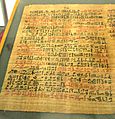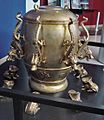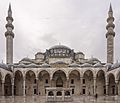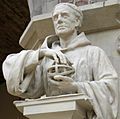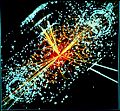History of science facts for kids
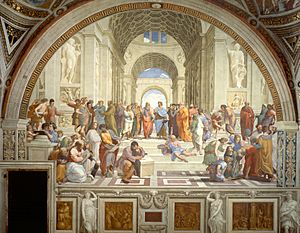
The history of science is all about how our understanding of the world has grown over time. It looks at how people learned new things and how science became what it is today. The word "scientist" is actually quite new! It was first used in the 1800s by William Whewell. Before that, people who studied nature were called "natural philosophers."
Science is a way of learning about the natural world. Scientists observe things, try to explain why they happen, and then predict what might happen next. This helps us understand real-world phenomena.
People have been curious about the natural world for thousands of years. In classical antiquity, especially in Ancient Greece, people made big steps in astronomy and mathematics. For example, Aristarchus of Samos suggested that the Sun was at the center of our Solar System long before Galileo thought of it. Other thinkers like Thales and Aristotle also spent a lot of time studying nature.
Contents
How Science Grew Over Time
People started using scientific methods during the Middle Ages, with figures like Roger Bacon. But what we call "modern science" really began in the 1500s and 1600s. This time was known as the scientific revolution in Europe.
Many important people helped shape modern science. These include Isaac Newton, Johannes Kepler, Robert Boyle, Charles Darwin, and Albert Einstein. Their ideas changed how we see the world.
Some people think that earlier ways of studying nature weren't "scientific" enough. But most historians of science agree that these early efforts were still a part of science's long journey.
Main Branches of Natural Science
The natural sciences study the physical world around us. Here are some of the main ones:
- Astronomy: The study of stars, planets, and space.
- Physics: The study of matter, energy, and how they interact.
- Chemistry: The study of substances and how they change.
- Geology: The study of Earth's physical structure and history.
- Biology: The study of living things.
- Botany and Zoology: The study of plants and animals.
- Cell biology: The study of cells, the basic units of life.
- Genetics and evolution: The study of how traits are passed down and how life changes over time.
There are also many applied sciences. These use ideas from natural sciences to solve real-world problems. For example, Medicine uses biology and chemistry to help people stay healthy.
Related pages
Images for kids
-
The Ebers Papyrus (around 1550 BC) from ancient Egypt shows early medical knowledge.
-
Clay models of animal livers from 19th-18th centuries BCE, found in Mari.
-
A star list from Uruk (Iraq), 320-150 BC, showing constellations and distances.
-
Ancient India was skilled in metallurgy, seen in the wrought-iron Pillar of Delhi.
-
A modern copy of Zhang Heng's seismometer from 132 CE.
-
A 15th-century book of Avicenna's The Canon of Medicine.
-
A statue of Roger Bacon at the Oxford University Museum of Natural History.
-
Galileo Galilei, often called the father of modern science.
-
Isaac Newton started classical mechanics in physics.
-
Adam Smith wrote The Wealth of Nations, a key book on economics.
-
Alessandro Volta showing the first electrical cell to Napoleon in 1801.
-
In 1837, Charles Darwin drew his first evolutionary tree.
-
The atomic bomb led to "Big Science" in physics.
-
Watson and Crick used templates like this (for Adenine) to build their DNA model in 1953.
-
Alfred Wegener in Greenland (1912–13). He suggested that continents move slowly around Earth.
-
A possible sign of a Higgs boson from a simulated proton–proton collision.
See also
 In Spanish: Historia de la ciencia para niños
In Spanish: Historia de la ciencia para niños


